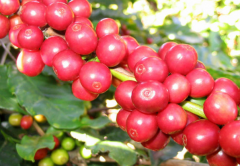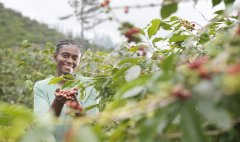Introduction and nomenclature of various rare coffee varieties
Acai á: a rare Mundo Novo mutation found mainly in Brazil.

Anacafe 14: a spontaneous Catimor-Pacamara hybrid further developed and released by Anacafe in 2014. This variety is considered to be rust-proof and produces high cup quality.
Anton sari (Andong Sari): a variety developed by popular Catimor from Colombia to Indonesia, crossed with Caturra and Hibrido de Timor (HDT).
Arusha: the most common unexplained typical / bourbon threat subspecies in Tanzania and Papua New Guinea.
Ateng: a common name for Catimor coffee widely grown in Sumatra and other Indonesian islands.
Batian: this disease-resistant strain released at the end of 2010 was named after the highest peak of the mountain. Kenya.

Blue Mountain: a typical mutation originally discovered and cultivated in the Blue Mountains of Jamaica.
Bourbon / bourbon: a taste and aroma reminiscent of BlackBerry or blueberry. Some of the best coffees in East Africa and Arabian Peninsula have these characteristics.
Bourboncillo / Bourboncito: short bourbon widely grown in Guatemala and other Central American countries.
Castillo: the improved Colombian variety developed by the Colombian National Coffee Research Center (Cenicafe) is currently the most widely cultivated variety in Colombia.
Catigua: Catuai and Hibrido de Timor were jointly developed by Minas Gerais Agricultural Research ("EPAMIG") in the 1980s.
Catimor: a hybrid Timur (resistant to coffee leaf rust due to its Robusta genetic roots) and Caturra, developed in Portugal in 1959, was introduced to Brazil in the 1970s.
Catua í: a hybrid of Mundo Novo and Yellow Caturra developed by the Brazilian Campinas Institute of Agronomy (ICA) in 1949.

Catuca í: a mixture of Icat ú and Catua í, in red and yellow forms.
Catucai-a ç u: a Catuca í (sometimes shown as Catucaia ç u or Catua í A ç u) registered in 2000 by Propoma de ApoioTecnol ó gicoclinic Cafeicultura (Procafe) of Brazil.
Caturra: a natural mixture of bourbon, responsible for profound changes and improvements in the world coffee industry.
Colombia: between 1968 and 1982, Setira and Timor hybrids were successfully hybridized for more than five years, developed by Senica province.
Costa Rica 95: Timor mixes the intersection between 832 Compact 1 and Katura. Pedigree selection (selection of individual plants through successive generations) developed by the Costa Rican Institute (ICAFE).
Criollo / Criolla: natural mutations in Typica that are common in Peru, Bolivia and Colombia.
Erecta: can refer to Erecta or Caturra Erecta. Please click for more information.
Garnica: a cross of Mundo Novo and Caturra developed by the Mexican Coffee Institute (INMECAFE) in 1960, mainly found in Veracruz and Chiapas, Mexico.
Geisha / Gesha: an once rare species that was "rediscovered" in Panama in 2004. It is widely considered to be one of the most complex, intense and satisfying varieties of coffee.
HDT (Hibrido de Timor) / Tim Tim: the cross between Arabica and Robusta is widely used as a genetic source for different breeding programs in order to develop high resistance to leaf rust and other diseases.
ICAFE 90 and CR 95: rust resistant varieties developed by the Costa Rican Coffee Institute (ICAFE)
Icat ú: a variety first developed in Brazil by the Brazilian Agricultural Research Center (IAC), known for its high productivity and good disease resistance.
IHCAFE 90: (also known as IH-90) A Carurur / Sarchimor hybrid variety developed by the Honduran Coffee Institute (IHCAFE) in the 1990s.
Jantung: strain Typica from the Aceh region of Sumatra.
Java: received its name from Java, Indonesia.
Kent: considered a typical natural variation found in India, it is widely found in Kenya today.

Lempira: considered to be a subvariety of Catimor found mainly in Honduras.
Longberry: a variety of products mainly from Indonesia, named for its appearance, which is longer and thinner than other coffee varieties.
Maracaturra: Brazilian hybrid of Maragogype and Caturra.
Maragogype: a natural mutation of Typica, first discovered in the town of Maragogipe in the Brazilian state of Bahia.
Marsellesa: a variety obtained from a cross between Sarchimor and Caturra. Its excellent cup quality and leaf rust resistance are sought after.
Mocha / Mocha: can refer to a variety from Yemen, or it can be an Indian variety common in Brazil and Hawaii. Click the link for more information.
Mundo Novo: Typica subspecies, a natural hybrid of Sumatra and Bourbon.
Obata: the crossover between Timor Hybrid 832 Universe 2 and Villa Sarchi CIFC 971 Universe 10. Pedigree selection conducted by the Institute of Agronomy, Sao Paulo State, Campinas, Brazil (IAC). The Costa Rican Coffee Association (Costa Rican Coffee Association) was launched in Brazil in 2004 and went to Costa Rica for commercial distribution in 2014.

Oro Azteca: the first heat-resistant coffee variety developed and registered in Mexico. This variety comes from the root system of Catimor (Timor Hybrid) which was bred with Red Carurra.
Pacamara: a hybrid variety created by the Coffee Institute (ISIC) in El Salvador that hybridizes the Pacas variety (El Salvador mutation in bourbon) with Maragogype.
Pacas: the result of a natural and spontaneous mutation of bourbon is found in El Salvador, the most common one today.
Pache: a natural mutation of Typica that was first discovered in Guatemala.
Pluma Hidalgo: a descendant of "Typica", first cultivated in Mexico, was introduced to an area called "Pluma" (Loxicha region of South Oaxaca).
Rasuna: the Sumatran hybrid of Catimor and Typica seems to be grown only in Indonesia.

Rubi: a mixture of Mundo Novo and Catua í designed at the Campinas Institute of Agronomy (IAC) in the 1960s.
Ruiru 11: a disease-resistant variety widely cultivated in Kenya.
S795: known as "Jember" in Indonesia, this variety is considered to be a hybrid of S288 (a natural hybrid of Liberica and Arabica) and an old Kent variety.
San Francisco: bourbon and Pacas blend from El Salvador. Also known as Hibrido de San Francisco.
Sarchimor: cross between Costa Rican Villa Sarchi and Timor Hybrid is widely cultivated in India and Costa Rica.
SL- varieties: including SL-28 and SL34, developed by Scott Lab, a Kenya-based research institute that developed a variety of contracts between 1934 and 1963. Click the link for more information.
Tabi: a variety developed by the Columbia Coffee Institute (CENICAFE) from the cross between Typica,Bourbon and Timor Hybrid.
Top á zio: varieties obtained from the crossover of Mundo Novo and RedCatua í, and then crossed again with Catua í. Developed at the Campinas Institute of Agronomy (IAC) in Brazil.
Toraja Toraja: a typical natural variety named after a region of Sulawesi, famous for growing coffee called Tana Toraja (or "Land of Toraya").
Typical: varieties that form the genetic skeleton of many special coffees today. The first coffee varieties grown in the Americas and Asia were typical, and many of the most widely grown Arabica coffee crops now come directly from plants.
Venice: a variety that originated in San Carlos, Alajuela, and is found on 100% Catura coffee plantations. It was chosen because it showed increased productivity, larger fruit size and increased rain-resistant fruit.
Villa Sarchi: a bourbon variety originally bred in a village called Sarchi in Costa Rica.
Important Notice :
前街咖啡 FrontStreet Coffee has moved to new addredd:
FrontStreet Coffee Address: 315,Donghua East Road,GuangZhou
Tel:020 38364473
- Prev

The importance of coffee classification and grading How is Ethiopian coffee grading divided
Ethiopia is the first country to discover coffee. It is the most important producing country in terms of coffee quality and yield. The annual production quantity is about 350,000 tons. Ethiopia is famous all over the world for its mocha beans blown by the sea. Yirgacheff is the Arabica produced by Sidamo in the south at an altitude of 1700~2100 meters.
- Next

Introduction of eight major coffee producing areas in Ethiopia introduction of coffee flavor in Yega Fischer
Raw beans are excellent in appearance, consistency, freshness to dry aroma and flavor. With the characteristics of Yejia Xuefei, raw beans exude a charming aroma of sun fruit! Sweet dried peach aromas with sweet citrus fruit aromas and lovely orange fruit cocoa rhymes balance the overall tonality ~ rich acidity and full aroma! The overall taste is smooth and delicate, with good sweetness.
Related
- Beginners will see the "Coffee pull flower" guide!
- What is the difference between ice blog purified milk and ordinary milk coffee?
- Why is the Philippines the largest producer of crops in Liberia?
- For coffee extraction, should the fine powder be retained?
- How does extracted espresso fill pressed powder? How much strength does it take to press the powder?
- How to make jasmine cold extract coffee? Is the jasmine + latte good?
- Will this little toy really make the coffee taste better? How does Lily Drip affect coffee extraction?
- Will the action of slapping the filter cup also affect coffee extraction?
- What's the difference between powder-to-water ratio and powder-to-liquid ratio?
- What is the Ethiopian local species? What does it have to do with Heirloom native species?

